|
|
Review GSM phone Motorola RAZR V3x
The company of Motorola took a great step by launching its RAZR handset and now keeps exploiting the achieved success. The sales of the original RAZR grew, and this pushed the company to reconsider titles of some current and announced models. And for instance, Motorola v1150 miraculously turned into RAZR V3x.
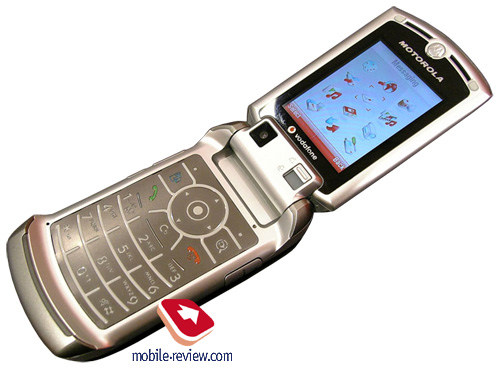
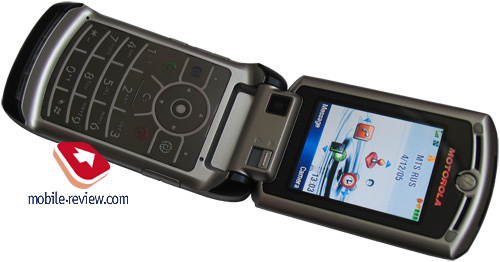
This rename was carried out mainly to emphasize the "slimness" of the solution with all available means for this class and take some fame and attention from a successful fellow. It's a safe strategy, and the "second" announcement of the model raised a wave of permanent interest. When the model was put on the market in some countries, the model was discussed very actively. And the major part of this interest is caused by the functional component of the phone, as it is the first Motorola's 2MP cameraphone. And technically the handset is very meaningful for the company also. That was the first time when hardware and software transfer to phones with higher resolutions was committed (later this process will be automated more and thus will not cause problems), and a new Nvidia's graphical accelerator was tested. It is the first representative of the GoForce family, a low-end solution with low productivity, and the RAZR employs an ATI's accelerator with a similar performance. Thus a user is unlikely to notice any difference in either games or phone's behaviour. And finally, the gradual improvement of user functions touched the handset also, now the phonebook is absolutely optimal. By the way the model collected almost every changes present in Motorola RAZR V3i. However, even more improvements and additions are planned, which makes the RAZR V3x to be an intermediate solution.
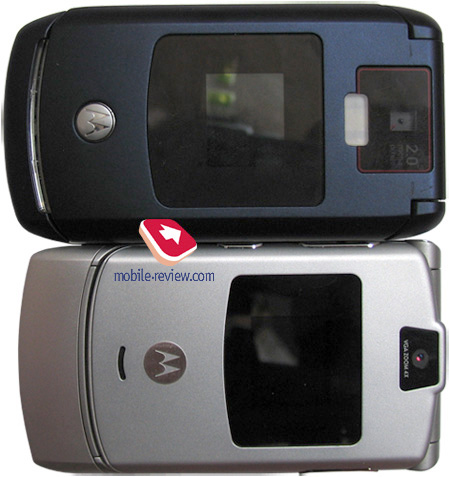
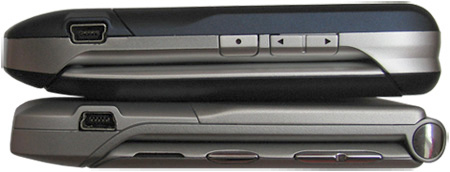
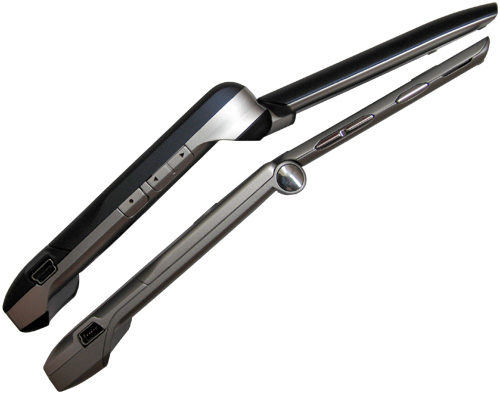
Considering the model's positioning, we can certainly say that the expected life cycle is much less that of the original RAZR. The device is mainly targeted at 3G operators, and is supposed to become one of the cheapest clamshell solutions with a formal set of characteristics. The manufacturer is capable of reducing the price actively, which will make the V3x attractive for its entire life circle, which will probably last for 6-8 months. Being a 3G phone, the model gives birth to a line of products, or to be precise, belongs to this family. Even in May the first handsets replacing the discussed phone will appear, though they will differ in software and design a little. And in summer a fully-functional replacement will be launched. However the V3x will have already acquired some copies on the market by that time, and one of them belongs to Benq Mobile.
The retrospective review of the model proposes Motorola v500 as the closest model to the V3x's position. It took an intermediate position in the triplet line, providing with Motorola v600's functionality but another body material, no light indicator (haptics), and smaller price. At the same time, the solution won over Motorola v300 in functionality, which also made it attractive. Extending this view on the current model line, we can say that the V3x is positioned above the RAZR, however is below or on the level of the V3i. Extra score is given for UMTS and the camera, which first positions it above the V3i (but really, the fashion component is weaker, which implies another price policy).
The vision of the end-consumer by market specialist of the company created the phone's appearance. This is a middle-aged man, who is not afraid of dealing with devices are equipment, who actively speaks on the phone and appreciates sensible price/quality ratio. The fashion component is still meaningful for him, however comes to the background. The head features are a camera, mp3 player, memory card, large screen and so on. However, such users do not belong to the Techi group, as the represent a mass customer group not very exacting in realization of some functions, they are first interested in general quantity and the end price. The second sales focus is placed on customers attracted by the unordinary design and the RAZR popularity (the same effect that the iPOD name makes). Women audience is nominal and will be minor.
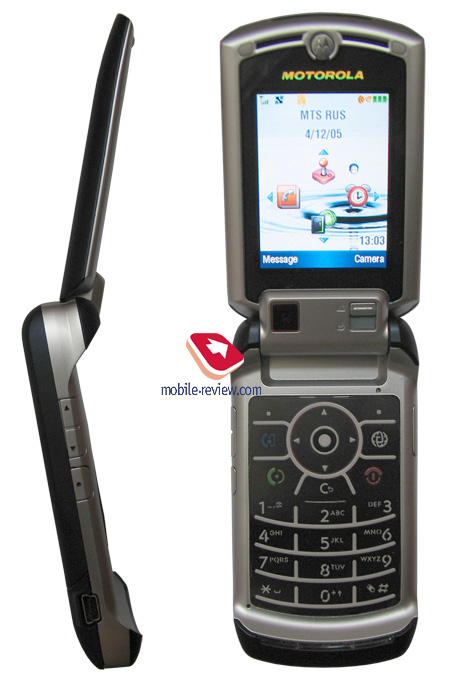
The point, which makes the model even more interesting, is its design is very interesting, not hackneyed and has nothing in common with the original RAZR. The body material is soft touch plastic, which has become mass for many manufacturers and for Samsung first of all. The main part of the body is in the same colour, and a silvery side edging rounds the whole body. It appeared here to make the phone thinner visually. And I think that is not a good solution, as the V3x can't be taken for a "slim" model. Many people, who dealt with it, say it is rather a big phone with considerable width. Such impressions appear when we rely on our sense organs but not exact metering.
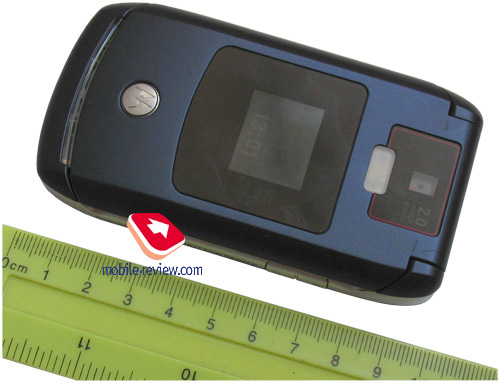
The dimensions form 99x53x19.8 mm, which is typical for the majority of modern phones. The handset is higher and thicker than the RAZR V3. However, comparing the models placed nearby, you will probably think the V3x is not as big as it seemed at first. But place Sony Ericsson K750i nearby, and you will notice the dimensions (not the width) ate comparable. And here is where a contradictive impression appears - sense organs tell the handset is not small, but the measurements prevent from calling it a big one.
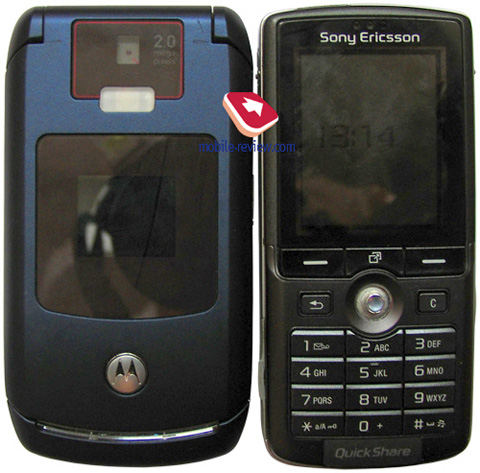

That is something in the middle; you should estimate the dimensions personally. The body colour can also influence the impression, as dark saturated colours weight the model and make it subjectively bigger (for instance, the dark blue colour in our case). A light body (for instance, a titanic colour) makes a visually lighter appearance.

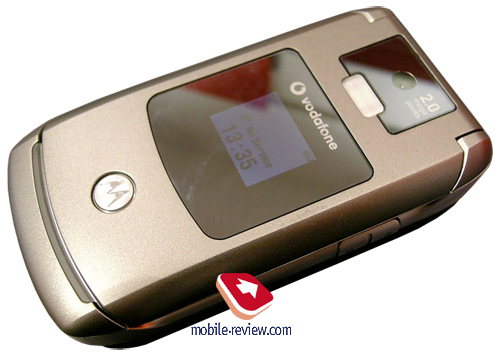
This difference in perception is not great; however it may play a decisive role. The phone weight is typical of UMTS phones and raises no cavils - 118 grams. And to decrease the general phone weight, the maker applied plastic.
The camera module and a light diode flash can be seen on the front panel. The CMOS camera coincides with the latest Motorola's devices, however provides with a higher photo resolution. The camera software improved due to the presence of GoForce 4200 chip, and now the photo quality is better.
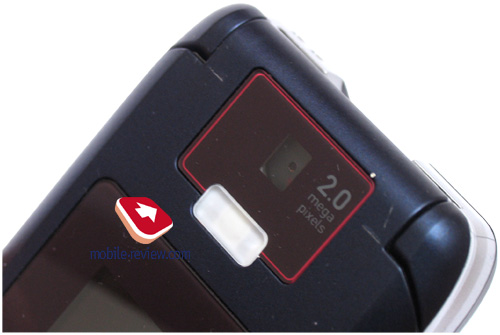
The integrated flash can be effectively used when shooting in the dark, as it is very bright and works in the distance of 2 meters. In fact, its lighting quality is even higher than in Sony Ericsson K750i, Sony Ericsson W900i, and Nokia N71. But unfortunately the developers provided with no "flash as a lamp" work mode.
The construction of the camera is not unique, however appears quite unordinary for European products. It is integrated into the clamshell's fold, for the module is too big to place in into the thin upper phone part. Considering such restrictions, the developers could not integrate an autofocus module (no industrially available solutions, or they are too expensive). The solution was finally found, and an extra lens was integrated. It acts as a macro objective. You just need to shift the toddler on the internal side of the phone to change the modes. The switch is rather big, according to the lens' size, to prevent the mechanism from faults at a hit and mechanical impact. It will take you only a second and no effort to switch modes in the new V3x, though the toddler is quite tough. With time and active use, the toddler may get distorted and you will need to improve its position in guiding rails. Such construction implies problems potentially and now consider frequent falls. However if you treat it carefully, the toddler will cause no problems. You should understand that the presence of this lens system is a forced compromise. That is impossible to achieve comparatively small thickness and implement autofocus.
The company doesn't emphasize on the glass lens used in the phone. However to be precise, the objective is combined and consists of 4 elements, which are two plastic and two glass ones. Glass lens are used in macromode, which influences the photo sharpness and colour saturation. And a graphical chip GoForce 4200 processes the photos, which is now its only duty.
A VGA camera is placed to the left of the toddler. It serves for video conferencing, and also you can get photos with it (that it quite enough for a portrait, as no high resolution is required).

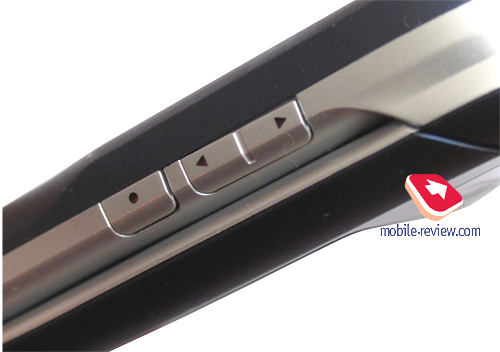
Two volume buttons found room on the left of the phone, a traditional for Motorola Smart-key is below, its capabilities depend on the menu settings (it can either be Push to Talk or selection of the current item). A standard miniUSB connector is a little below, and it serves for connecting a charger. A camera button and access to voice functions are on the right side (in particular, it activates voice dial or makes dictaphone records by holding the button). A strap hole is on the top end.
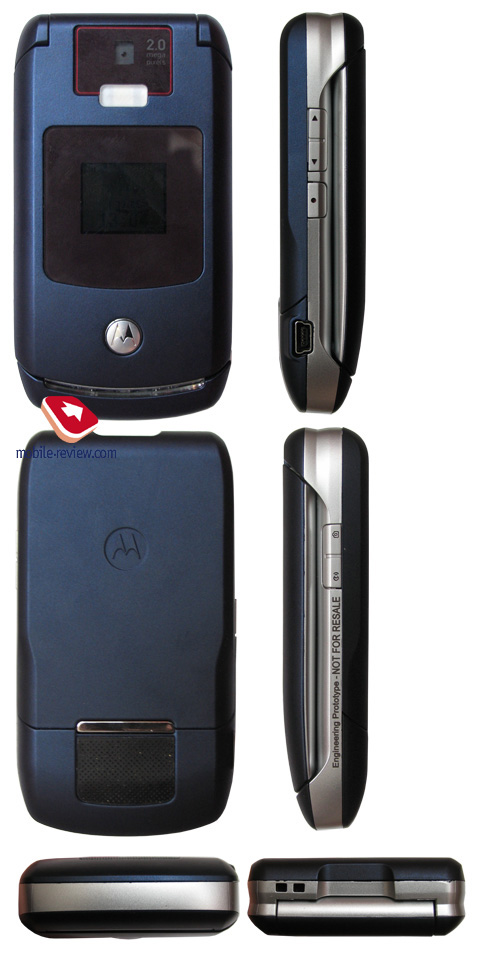
This model is equipped with an external screen, which is capable of 65K colours and has the resolution of 96x80 pixels (21.1x17.8 mm). The screen quality is medium, and we can't call this STN matrix the best. The display fades in the sun and you will hardly make the picture out. When you receive a call, the assigned image is shown not full-screen, the photo or the image is rectangular and takes only a part of the display, which adds no comfort for a user.
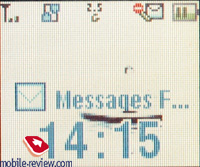
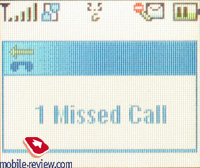

A semicircle light diode indicator is made of transparent plastic and placed closer to the bottom end. Only red backlighting colour is available for the indicator, this one appears when charging the device or at events (an incoming call, an organizer event, a message). It can light up smoothly and fade slowly, however that is no a full-functional colour support, which was first realized in Motorola v80. At the same time the size of the indicator makes it act not as a nominal addition to the general phone's functionality, but it plays an important role and is well seen under any conditions. One may claim this indicator breaks the integrity of the phone and mismatches its appearance. As for me, the handset is positioned as a cheap solution, which justifies such an indicator. And also note that fashion models now also provide with only one backlighting colour. Now the difference concerns only the shape, position and the main colour of indicators.
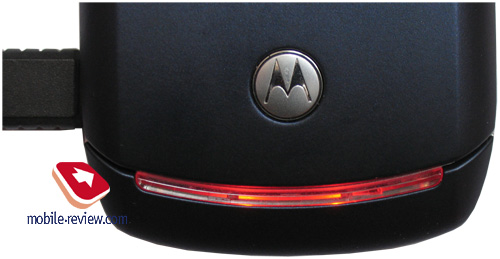
You can open the handset with one hand; the spring is not very tough, which makes the motion easy. The internal phone's screen is made by Sharp, which means it is one of the best in its class. High picture clearance, well processed details are peculiarities of the display. It is TFT and shows 262K. The screen resolution is 240x320 pixels (33.84x45.12 mm), which allows 7 text lines and tips for soft-keys use. The dot size forms 0.141 mm. From 16 to 24 characters can be placed on a single line. This screen even can't be compared with the one integrated into Motorola RAZR, its characteristics are higher. And even Motorola V3i loses in lower resolution. The display of the V3x is the best in the Motorola's product line for the moment.

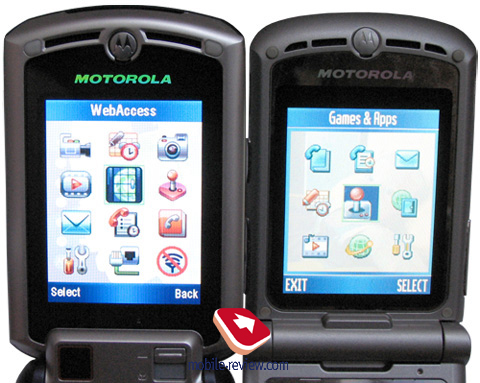
The key block matches the RAZR style, which is a metallic plate with etched keys. Despite the external similarity of the keypads, the impression of their use varies greatly. So, Motorola V3x has rubber insertions between the buttons, which rise above the keys and divide them.
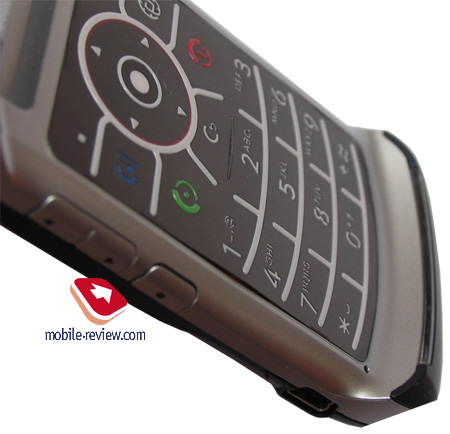
The technology is rather interesting. Cuts are etched on the first stage (for instance, letters and numbers). And then a rubber base is squeezed thought the received gaps. As it starts projecting above the surface, you can avoid looking at the keypad when dialing a number or dealing with other phone functions if you remember the key disposition. The key orange backlighting is well seen in various conditions.
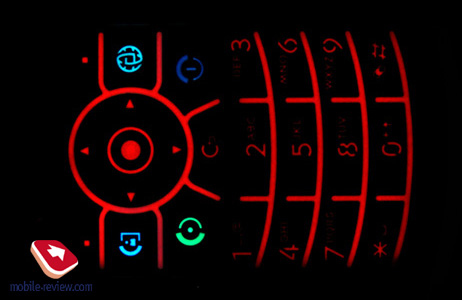
Due to the body thicker than in RAZR V3 or similar products, the V3x allows you to feel the key motion at pressure. The keys are comfortable to work with, and the key area is big, which makes them very pleasant. A keypad indicator activates the backlighting only at complete darkness or in poor light.
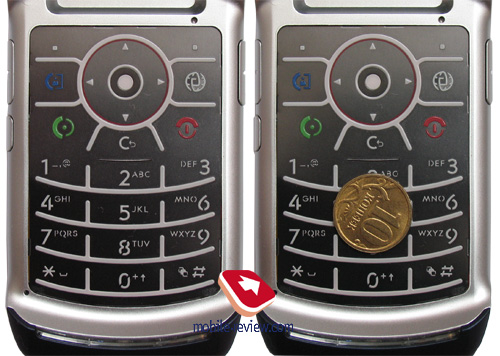
A metallic grid on the back panel hides the main loudspeaker. We should praise the good loudspeaker design, as the grid looks very stylish. However we incorrectly supposed that the sound will be too low when the handset is in a case and pressed with its loudspeaker close to the body. The main one used during conversations duplicates it. The body construction allows the sound of this loudspeaker to go to the fore panel. If you open the device, you will see a loudspeaker's gap on the top. That is a big slot. When the handset is closed, the sound gets to the body lug and is reflected up (and that is the front panel). You should understand that these loudspeakers are different in power, but this solution allows carrying the phone wherever you like.
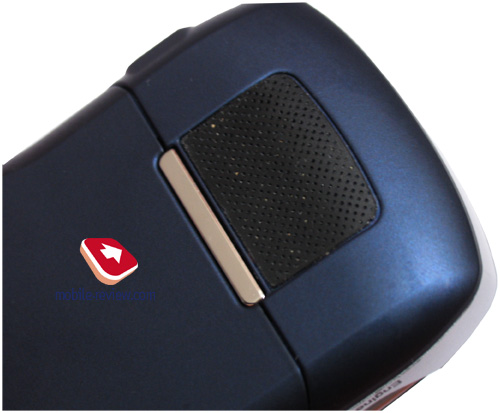


A battery compartment and a memory slot are behind the cover. The cover is fixed well, without any backlash. Hot card change is supported, but you will always need to remove the back cover, the card type is microSD (TransFlash). The SIM-holder is standard, and you can change the card without removing the battery, which gains some sense at the presence of the "aboard" mode.
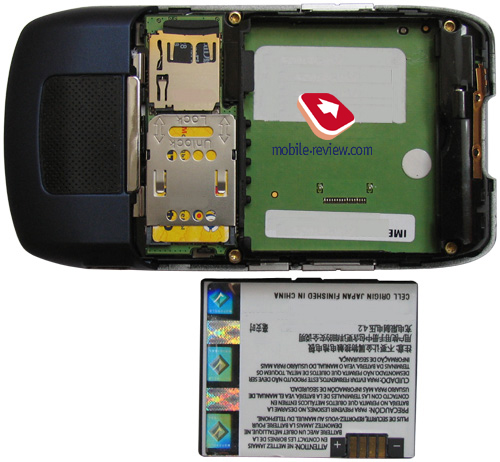
The integrated battery is 820 mAh (BC60, which is equal to "slim" models like the L7). As the manufacturer claims, it is capable of up to 200 hours of work in the standby mode and up to 4 hours of talks. In Moscow the handset lasted for about 2 days in case of 50 minutes of talks, up to an hour of listening to music and minimal use of other functions. If you have active Bluetooth and use a headset for a close number of calls a day, you will have the battery life 10-15 percent reduced. The longest battery life we observed reached 2.5-3 days at the minimal number of calls (that is how long the mobile phone lasted in London). Thus, you should rely on one-two days of stable work in the best coverage conditions. Using stereobluetooth-earphones to listen to music on the device will reduce the battery life dramatically. The battery may discharge completely in some ten hours, and then you will have to spend about two hours recharging it. If you connect the phone to a PC via a cable, it will start recharging, but certainly that will take longer.
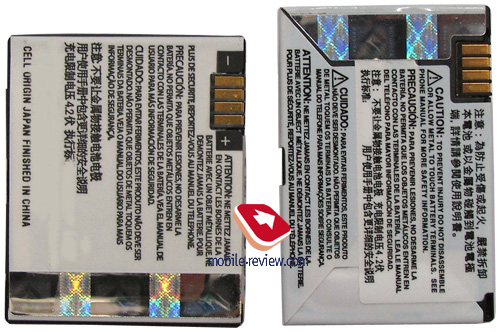
The appearance of Bluetooth A2DP profile, which allows transmission of sound to a Bluetooth-headset, should be mentioned as a hardware peculiarity. The GET method is traditionally forbidden, which prevents from viewing the file structure on the phone using other devices. The solution is used exclusively due to political reasons, and probably it will be cancelled in future models under the pressure of unsatisfied users (that is extremely uncomfortable, and there are actually no reasons for this restriction).
Menu
In fact, the model is a real cocktail of functions borrowed from old phones, improved ones which have been introduced lately and new solutions. That is mainly a detonating mixture sometimes combined inadequately, however rather pleasant in actual fact like many exotic cocktails. And still we can't call the phone's adjustment detailed, as many functions seem rudiments, for instance, the absence of voice dial independent on the speaker's pronunciation (a peculiarity of all latest models). On the other hand normally organized phonebook allows forgetting about it. Yes, that finally happened, the company decided on implementing a normal phonebook.
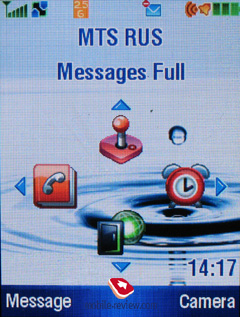 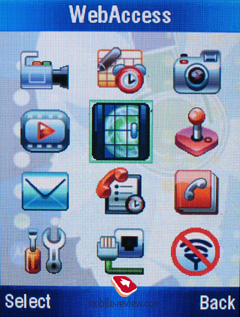
And now before deepening into details, I'd like to say a couple of words about the phone's memory, its division and restrictions.
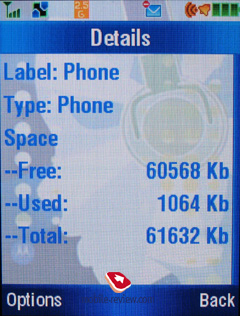 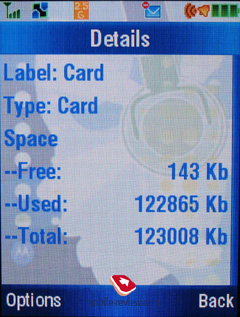
The phone contains 62MB of user-accessible memory, and the system takes approximately the same memory allotment (this is not shown to a user). A curious fact is the system can be allocated in 32 MB, and that seems that to unify the handset a 128MB chip was integrated (or maybe we were so lucky, and first party phones were not shipped with regular memory size, which sometimes happens, this plays no role to a user).
An executable Java file is restricted to 1MB in size (the size of a JAR-file), while the HEAP can reach 2MB. Actually which memory type is used doesn't matter to the phone when working with files (music, calls, photos, applications), but the interface speed in lower for the internal memory (though it should be vice versa considering logically). This put a restriction on the bitrate of mp3 files. And now the recommended bitrate for the phone's memory is 64 kbps and 128 for the card. However you should treat this statement as recommended by the maker, but not a serious restriction. The phone will play back files with 256 kbps or an alternating bitrate perfectly; problems appear very rarely for some specific musical compositions.
Memory for applications is distributed dynamically, 700 names are an assured number to save in the phone's memory. An organizer can remember up to 500 events and up to 400 task entries (or any combination of them not more than 900 entries in sum). An MMS is limited by 300 KB. So, let us examine the phone's capabilities in details and start with the phonebook.
Phonebook. More than 700 names can be saved in the phone's memory and for each entry you can save a Name, a Surname (two fields), Nickname, phone number (select its type of a list - home, work, mobile, fax and so on, available for videocalls or not). At entering a number you will get only one field, but be sure another one appears after you fill the given field. That means the phone offers step by step entry, which seems logical. Finally, about 7 numbers can be kept for one name, which is enough for the majority of users.
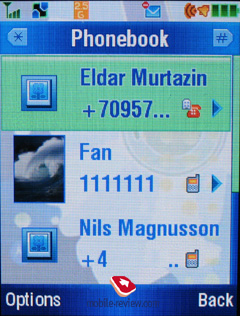 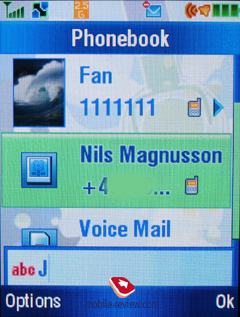
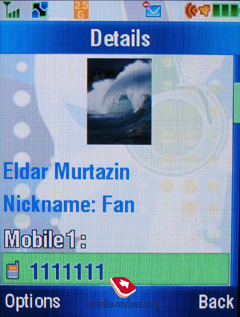 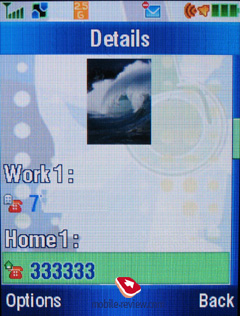
Besides numbers you can enter e-mail addresses (up to 2), URL, a postal address (two fields for a street, city, state, area code, country). Also we should mention a text note, a personal call melody, users' groups (unlimited number, and each one can have a personal melody), and a birth date. Automatically the zodiac sign is calculated from the birth date and a corresponding entry appears when you view the name. Unfortunately, no automatic reminder about the birthday appears in the organizer, no sound signals. And I consider it to be the next step in development of the phonebook.
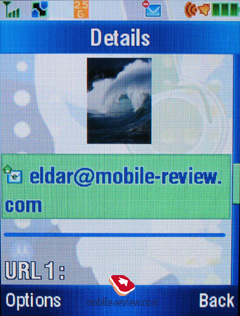
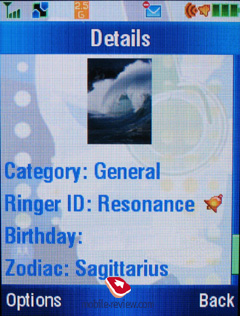
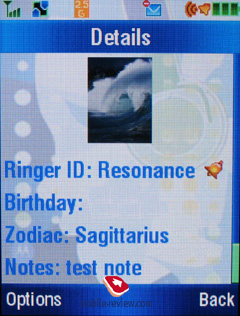 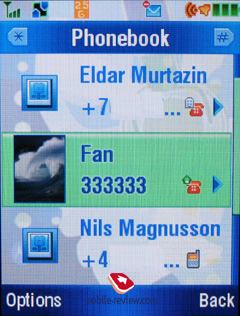
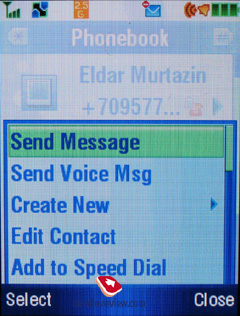
You can record voice entries, which contains no differences from previous phones. Though recognition works acceptably, it still fails in noisy places. Each name can have a photo or a graphical image assigned.
The general list shows names both from the phone memory and SIM (only one type is viewable at once). Search may be carried out by several letters and you can add till a complete word. Three views of the list are possible - only names with an icon of a default number, names and photos and the first phone number (a default one), names with a number. You can scroll names fast by horizontal pressures. Any number can be added to the fast dial list and you can send a message or call a selected number in a pop-up menu.
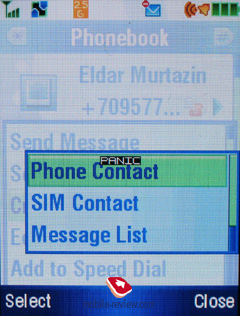 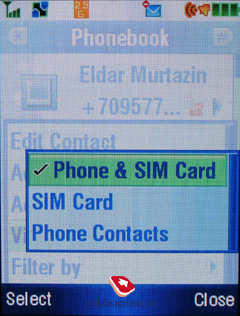
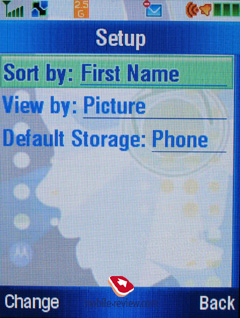 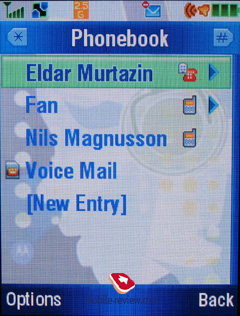
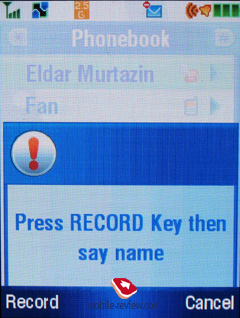 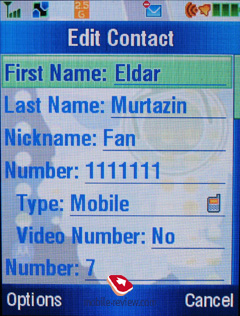
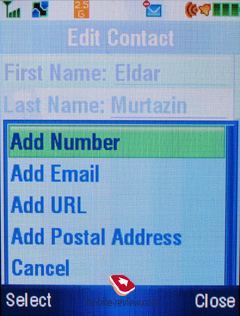 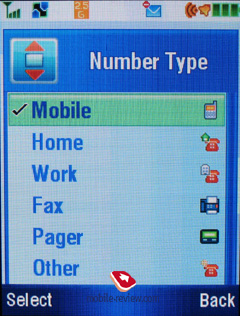

The phonebook is realized well. That is the first time Motorola considered negative feedback of users and developed a separate function, and did it well. Further expansion of the phonebook in next models will consist of more integration with the organizer and voice recognition independent on the speaker's voice. And even now the phonebook can't rouse cavils like it did before. Everything is plain and clear, and on the level of the best models by other makers.
You can receive contacts from other phones, which is a curious capability. And if names coincide, two entries are created. If one of the entries has a Nickname field filled, then the contact will be displayed under this nickname, but not under the Name and Surname.
Even despite some possible distortions of encodings for Russian, synchronization with MS Outlook brings no problems. We failed in finding the reason. However after a complete clean up of all entries and a repeated synchronization, all entries were displayed in normal Russian.
Messages. The default memory capacity for 100 SMS is provided; it may also vary depending on the software version. As a rule, operator versions are limited by 70 messages. The device works with EMS. Automatic cleaning of the whole message list should be mentioned as an extra possibility; there is a list of templates. Delivery report may be on permanently or switched on/off for a message.
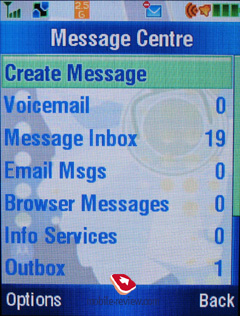 
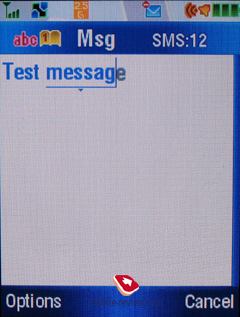 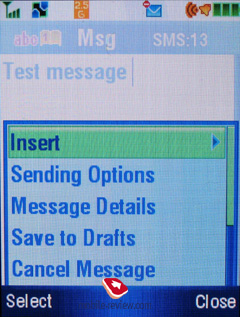
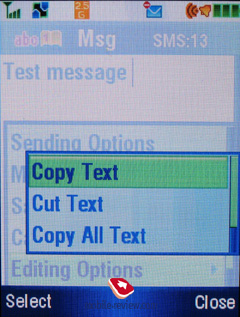 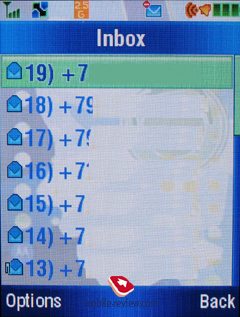
 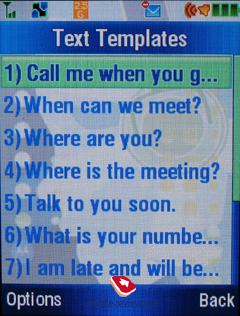
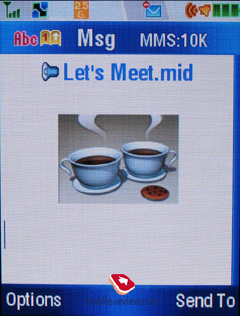 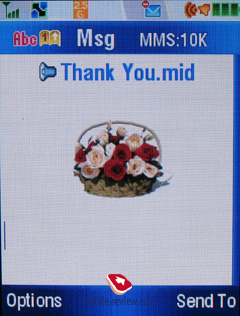
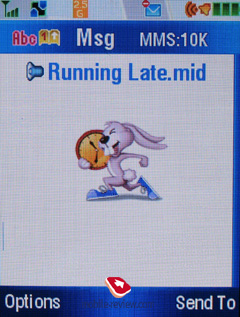
Working with MMS doesn't bring any inconvenience; everything is simple and easily understandable. The messages can be attached with pictures made by the built-in camera, sound files. The ten predefined templates are really great, be sure to check them out.
The phone has POP3/IMAP4 e-mail client, it allows watching the headers of the incoming mail and download their body as well. Only graphical files, video, mp3 that do not exceed a certain size limit can be sent. In case you want to store some of the e-mails, you will have to use the dynamically spread memory, just like in case with MMS.
WAP. The phone has WAP-browser v2.0 and its possibilities are standard so nothing special can be said. GPRS (class 10) is present, the settings are rather simple, just follow your operator's instructions.
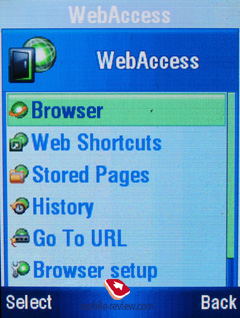 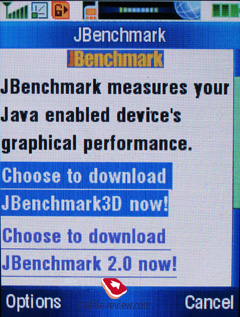
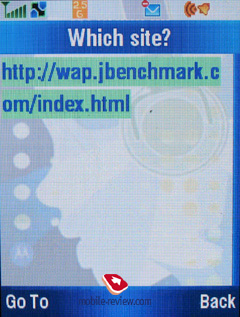 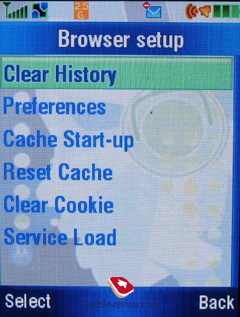
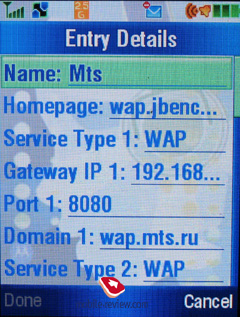 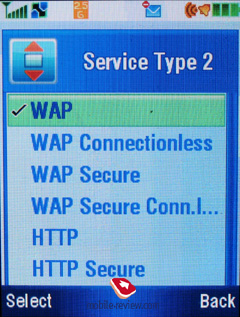
Call log. The phone has a list of received calls; it includes the missed ones as well, they may be distinguished by the absent tip. You can also see the list of 10 last dialed numbers; you can access it by pressing the Call button. Not only the caller's name but the type of the number is shown, if it is kept in the phonebook. Everything is rather simple and traditional, nothing special at all. Each entry features the date and time as well as the duration.
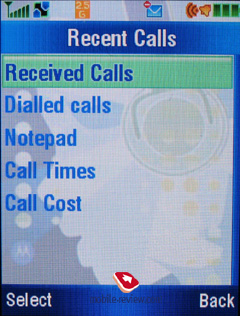
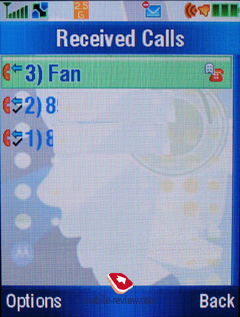 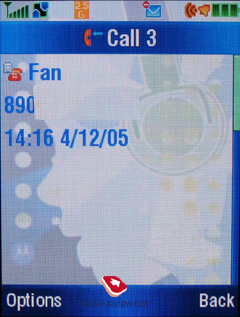
Also this menu shows battery life, last calls, call duration and data connections.
Office applications. This menu features a whole bunch of office applications such as the Calculator. It's convenient, the full digital keyboard is present on the screen, it reproduces the real keyboard perfectly. The menu features memory options and the unit converter.
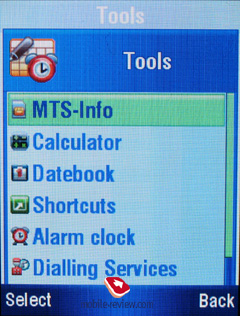 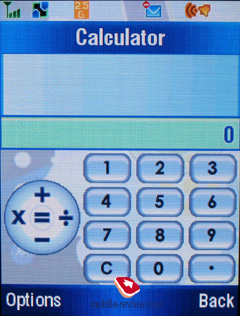
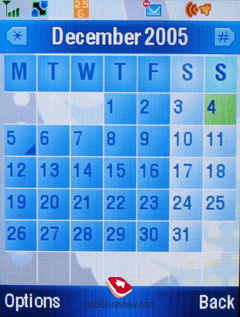 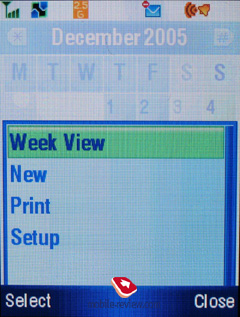
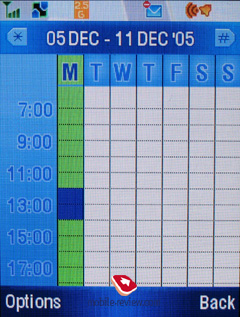
Shortcuts are located in the same menu. You can create shortcuts not only for various menu sections, but for a definite wap-site as well.
Alarm clock. You can create several alarm clocks and choose a custom ring tone, name and volume, type of reoccurrence (daily, single time) for each of them. This phone was designed for continuous, that's why entering names and titles for the alarm clocks is required. Alarm clocks are activated in one touch, and a note really eases work with them.
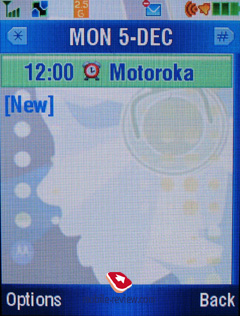 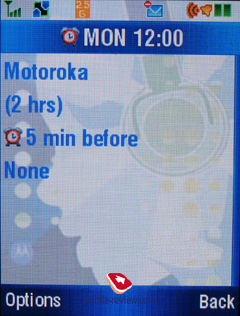
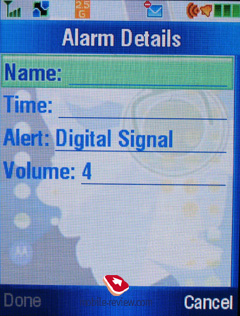
Dictaphone. You can create records from the stand by mode as well as during the talk. Dictaphone can record the whole dialogue. The maximum length for each entry - 60 seconds, however your interlocutor will hear the sounds (at first it's zoommer, followed by short beeps with a continuous interval). There is no possibility to keep more comments despite the dynamical memory present, only several records up to 60 seconds in duration (earlier the limit formed 120 seconds). The dictaphone is weak especially against a background of the rivals recording up to an hour of talks. In the listening mode a percent of the total time but not a reproduced time is shown, the discontinuity forms 5. That looks hardly comfortable since we all are used to representing record time and that seems logical.
Organizer. You can view it monthly or weekly with breakdown for hours. You will see your appointments bind to a certain time of the day, it's convenient. Each entry can be assigned with a name, start time, length (measured in hours, the minimal amount of time - 30 minutes). Warning can be set in advance. Each entry can be reoccurred, this is a big plus.
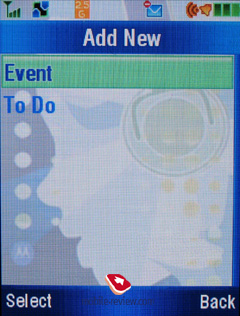 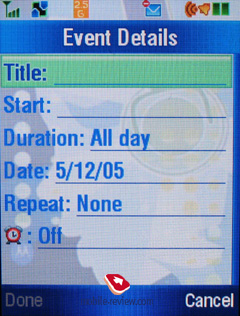
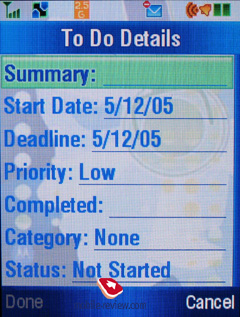 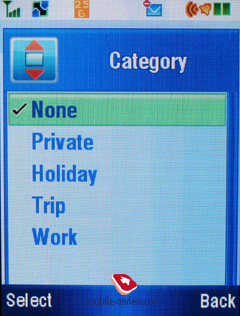
 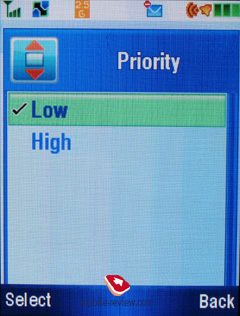
The task list was changed considerably, now you are allowed to select a category (None, Private, Holiday, Trip, Work), a status (Not started, In Progress, Completed, Waiting on Info, Deffered), priority (High, Low). This is the first Motorola's phone for Europe which employs such a list.
SyncML support is present, it's made for corporative users who are in great need of synchronization with data server (something similar to remote synchronization with Desktop PC, but this time the server must be located in the network).
Games and applications. The phone supports Java MIDP 2.0, all applications that are located in this menu item are based on this technology. The number of games and their title depends on where the phone was bought. The most often to find are Rebels (a space shooter), AspaltUrbanGT (races), BlockBreaker Deluxe (one of the best archaniods), Solitaire (patience), Flee (game for children).
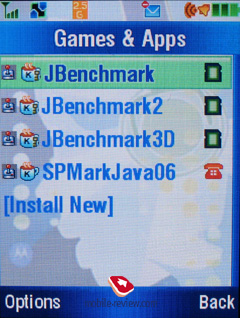
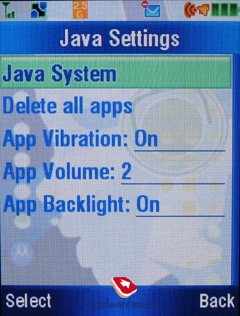 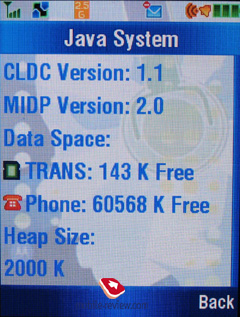
Applications now allow using the Safe program - once you set a password, and then can store confidential data about you bank account, passwords, addresses and so on. It resembles the ones in Sony Ericsson, Nokia, Siemens.
Multimedia. The phone supports themes. It's a set of wallpapers, color schemes for the menu, sounds and ring tone types. You can change the outlook of your phone almost instantly and this is really funny. New themes can be downloaded from Motorola's website.
 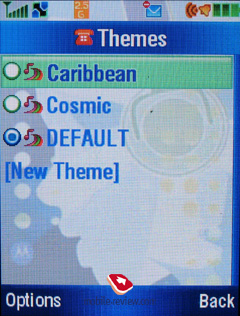
 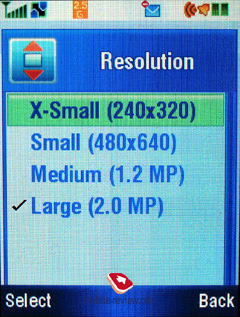
The skins number changed and they are quite different. They not only change a colour menu representation but interface windows, the whole interface of the phone changes.
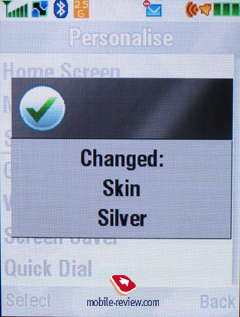 
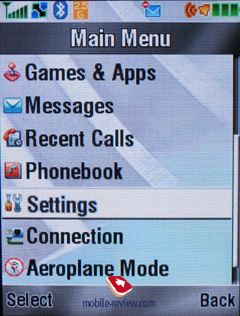 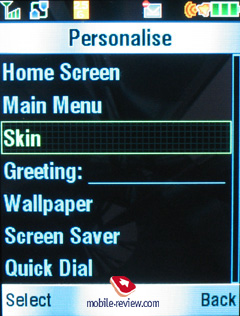
 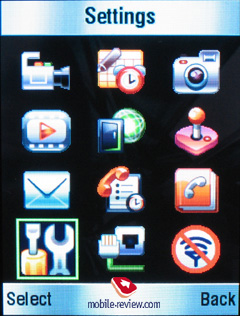
MotoMixer - original sound file editor that allows mixing the tracks. You can play with it from time to time; the results may come out rather unexpected and nice. However as the practice shows, these sound editors are nothing more than a toy for most of the users, only few of them take use tool seriously.
Sounds - information about all sound files located in the phone's memory is stored here. You can check out their size, info and even listen to them. The players is similar to other Motorola's phones, everything is clear and easy to understand. The great advantage of this very player is playing back mp3's in background. You can form you own play lists by the way.
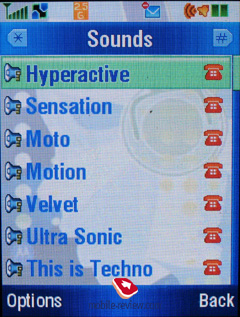 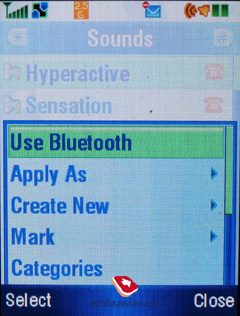
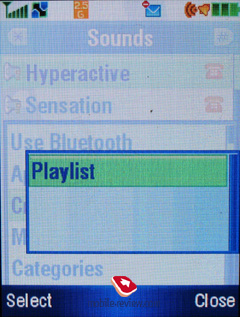 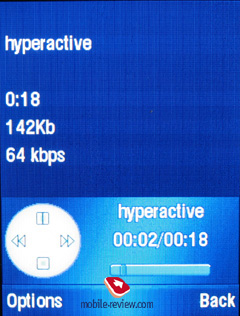
Pictures - list of all images located in the phone's memory. There's a special icon near the file name. Each picture can be set as the wallpaper or screensaver. Pictures can be sorted in categories; this will make the browsing easier.
 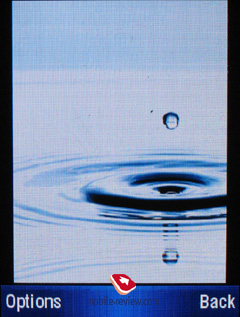
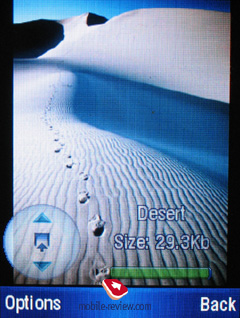 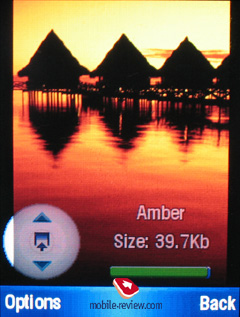
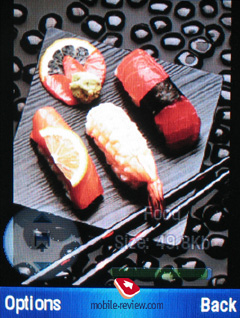 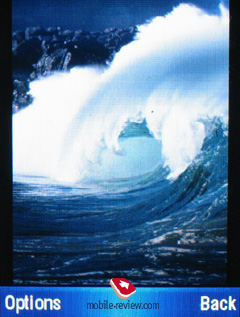
Even more, you can use an integrated editor, which allows putting frames, changing color scheme and using special effects. The most convenient part is that after mocking the picture it can be stored with a new name. This means that both the original and the new picture will be available for use. This may come handy in case if you want to edit the photo, and not to ruin the original.
Settings. Here you can setup all Display settings including the color schemes.
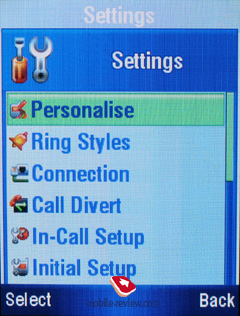 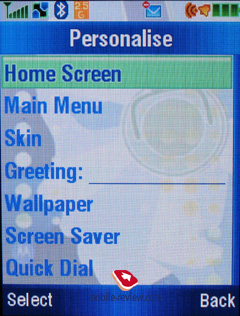
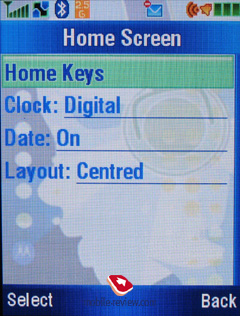 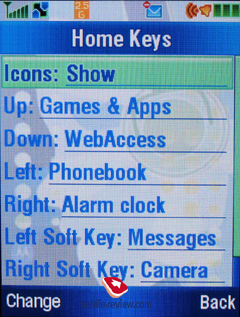
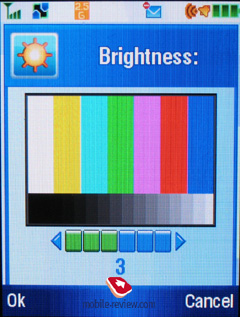
Ring tone type and notification mode (mixed mode, when the vibrating alert works at the same time with the ring tone is present) is here as well.
Here you can activate an aboard mode and by the way set an alert at activating. The absence of modes upsets, however this mode is the first step towards fully-functional profiles.
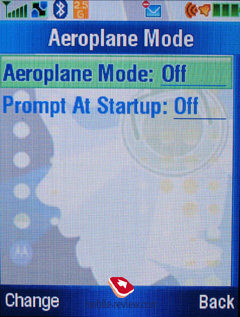
Security settings expanded greatly. Now you can protect some functions with a password, which may be the phonebook, messages, or some other phone sections.
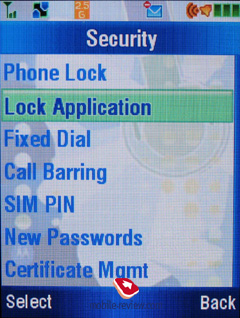
Bluetooth settings were slightly changed; the device is seen for 3 minutes now. Now the Print option is available, printing is possible for a message, an organizer note or a phonebook entry.
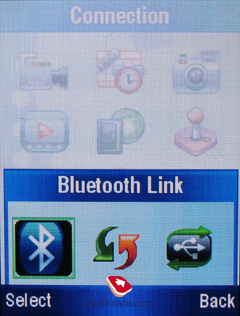 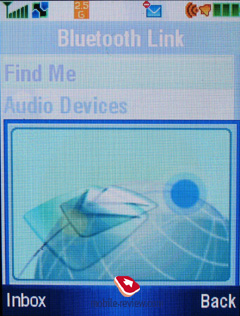
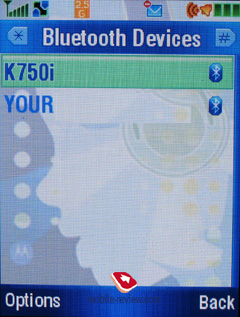 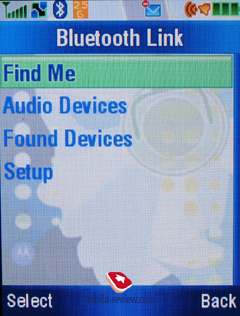
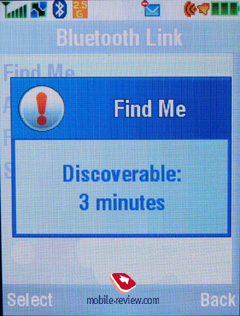 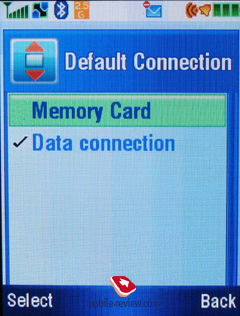
The supported standard is 1.2; besides the Print profile the handset now can provide Audio Profile (A2DP), which allows using stereo headset with it. You can't rewind the composition fast from the headset; however it will certainly help you change it.
Camera. With an integrated 2MP CMOS sensor you can take photos of four resolutions - Large (2MP), Medium (1.2 MP), Small (480x640), X-Small (240x320). Other settings allow turning off the shutter sound, from 02 to +2 exposition, selecting a lighting type (auto, sunny, cloudy, indoors, office). Timer shooting is also present.
You will get the best results at bright sun light and in other cases colour saturation is not enough. A pleasant peculiarity is a photo is shown full-screen when working with the camera, and tips are semitransparent. You can change lighting settings by vertical movement with a navi button, as well as select various effects (colour, black and white, blue, old-like, red, green, and negative). A digital up to x8 zoom is at your disposal.
The objective consists of 4 lenses, and effective distance makes from 60 cm to infinity in normal shooting mode. The best result is achieved when shooting from 2 to 3 meters. The focal distance of the objective forms 2.6, and GoForce 4200 processes the photos, which allows natural colours. The picture is not very detailed, artifacts are present and the model loses almost to all rivals in its class, and first these are products by Sony Ericsson and Nokia. However if you compare the cameras of V3x with one in Siemens SXG75, you won't say it is very bad, as the phones are comparable, though the V3x seems more attractive due to many various settings.
Here and further we provide photos and videos taken by our permanent reader and forum participant from Great Britain Naim F.C. Special thanks for the kindly provided materials.
Motorola V3x - Sharp 903
|
|
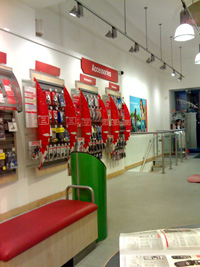 |
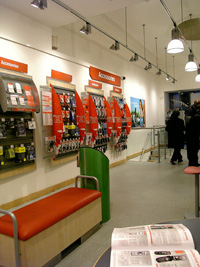 |
(+)increase, 1600x1200, JPEG |
(+)increase, 1536x2048, JPEG |
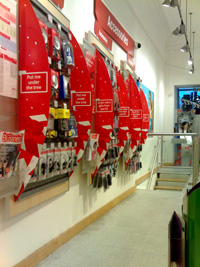 |
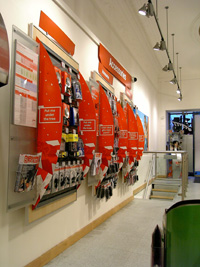 |
(+)increase, 1600x1200, JPEG |
(+)increase, 1536x2048, JPEG |
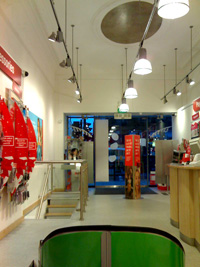 |
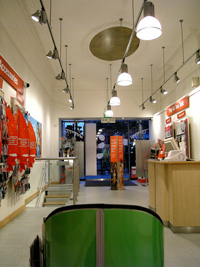 |
(+)increase, 1600x1200, JPEG |
(+)increase, 1536x2048, JPEG |
 |
 |
(+)increase, 1600x1200, JPEG |
(+)increase, 1600x1200, JPEG |
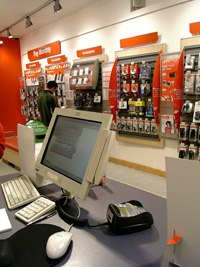 |
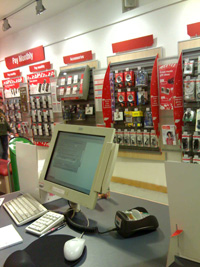 |
(+)increase, 1536x2048, JPEG |
(+)increase, 1600x1200, JPEG |
 |
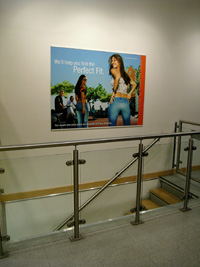 |
(+)increase, 1600x1200, JPEG |
(+)increase, 1536x2048, JPEG |
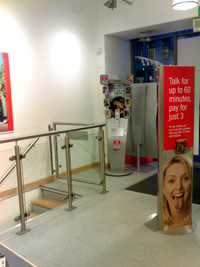 |
 |
(+)increase, 1600x1200, JPEG |
(+)increase, 1536x2048, JPEG |
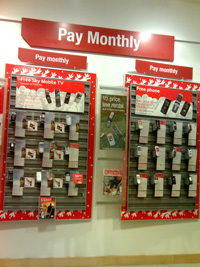 |
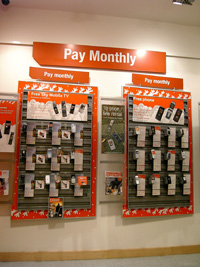 |
(+)increase, 1600x1200, JPEG |
(+)increase, 1536x2048, JPEG |
We used photos taken with Sharp 903 equipped with a 3MP camera to compare the quality. You can see photos by Motorola are less detailed. Two glass lenses are used in macromode, which provides a very clear image, so macromode looks well (though still loses to Sony Ericsson K750i). Effective distance for macroshooting is from 20 to 60 cm.
When you make a record, the screen is renewed about once per second, and is cleaned up after the record in 3 seconds.
|
|
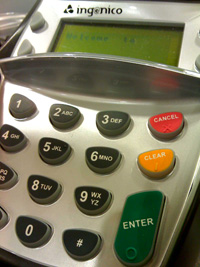 |
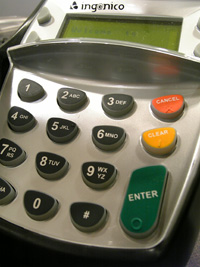 |
(+)increase, 1200x1600, JPEG |
(+)increase, 1536x2048, JPEG |
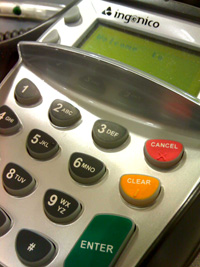 |
 |
(+)increase, 1200x1600, JPEG |
(+)increase, 1536x2048, JPEG |
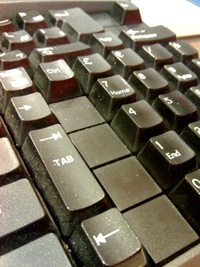 |
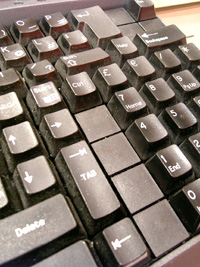 |
(+)increase, 1200x1600, JPEG |
(+)increase, 1536x2048, JPEG |
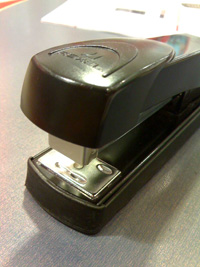 |
 |
(+)increase, 1200x1600, JPEG |
(+)increase, 1200x1600, JPEG |
You can select the quality for video - good, better, the best. The maximum clip duration reaches 10 minutes. And it is curious that a camera interface differs from the video camera and represents another menu item. You can change the settings quickly, however the picture then takes only a part of the screen, which is caused by the clip resolution (low - 128x96 pixels, high - 176x144 pixels). Video quality is middling, you can record it without sound. And the frequency is 15 fps.
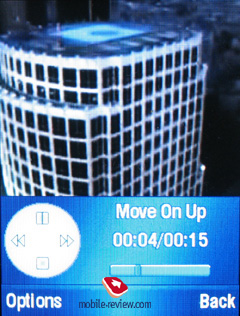
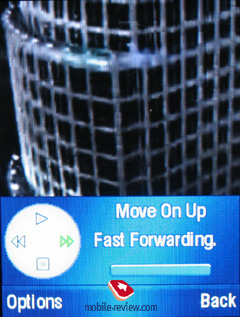

Sample
video 1 Motorola V3x (3GP, 278 KB)
Sample
video 2 Motorola V3x (3GP, 368 KB)
Sample
video 1 Sharp 903 (3GP, 1,30 MB)
Sample
video 2 Sharp 903 (3GP, 1,59 MB)
Phone's productivity. We used JBenchmark for our tests traditionally. The first package revealed so little improvement that is can be left out of account. And the second version showed considerable growth of performance, the model reached the middle level. The 3D package showed low performance, because the GoForce 4200 chip turned off. You should understand that the V3x is one of the first models supporting JSR-184, which means 3d games.
|
V3x
|
| JBenchmark 3D HQ |
68
|
| JBenchmark 3D LQ |
72
|
| Triangles ps: |
11176
|
| kTexes ps: |
1260
|
| Screen(canvas)width: |
240
|
| Screen(canvas)height: |
300
|
Details |
| M3G Version: |
1 |
| Antialaising: |
false
|
| True color: |
false
|
| Dithering: |
false
|
| Mipmapping: |
false
|
| Perspective correction: |
true
|
| Local camera lighting: |
true
|
| Max lights: |
256
|
| Max Viewport dimensions: |
1024
|
| Max Texture Dimensions: |
1024
|
| Max Sprite Crop Dimensions: |
1024
|
| Max Transforms Per Vertex: |
2
|
| Number of Texture Units: |
2
|
| Other properties: |
|
| Color Screen |
true
|
| Number of colors |
65536
|
| Transparency (alpha level) |
4
|
| Double buffer |
true
|
| Total memory: |
1955008
|
| Free memory: |
1033392
|
MicroEdition Configuration
|
CLDC-1.1
|
MicroEdition Profiles:
|
MIDP-2.0
|
Microedition Platform:
|
j2me
|
Microedition Encoding:
|
ISO-8859-1
|
Microedition Locale
|
en-RU
|
Microedition Communication ports:
|
COM0
|
| Microedition Hostname: |
null
|
3.1.0 |
|
V3x |
V3i
|
| Jbenchmark 2 |
126 |
32
|
Details |
| Image manipulation |
86 |
18 |
| Text |
162 |
143 |
| Sprites |
175 |
70 |
| 3d Transform |
111 |
4 |
| User Interface |
115 |
45 |
2.1.1 |
|
V3x
|
V3i
|
JBenchmark version
|
1.1.1
|
1.1.1 |
Total Score:
|
1172
|
1076 |
Details |
Text
|
240 |
333 |
2D Shapes
|
292 |
272 |
3D Shapes
|
229 |
119 |
Fill Rate
|
118 |
42 |
Animation
|
293 |
310 |
In general the model obviously loses to the majority of phones represented on the market in Java-machine operating speed. You can download applications directly to the device.
Synchronization with PC. A complete version of Mobile Phone Tools version 4.x is included into the package. The program capabilities cover the needs of the majority of users; they include synchronization with MS Outlook, making reserve copies on a PC, copying photos, melodies, writing messages on the PC.
Impressions
The model has no problems with the connection quality being a typical modern device. Musical component is on the triplet's level, mp3 play back is present and limitations are not as strict. Signal volume is higher than average, Midi-files are played in the 64-tones polyphony that sound well also. The vibra is average or a bit more powerful. The loudspeaker volume is enough during a conversation almost always.
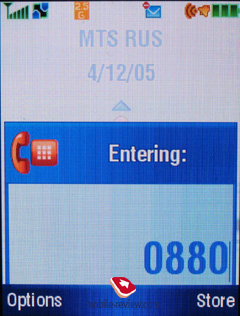
 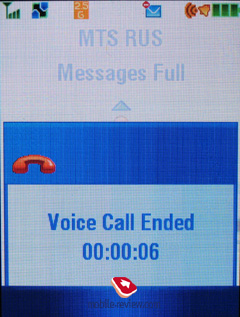
Due to the shortage of chipsets EDGE is not provided in the first shipped phones. And the company plans to solve the problem only in spring 2006. The second disadvantage is GoForce 4200 works only when the camera works. The developers had no time to finish the software, and as a result the graphical accelerator is used nowhere. On the other hand the company placed no emphasis on it when introducing the phone, so, everything is fair. Later the maker plans to realize a full support for the graphical chip, which will provide higher performance both in 2D and 3D applications. People who already bought the model will have problems with renewing the software and turning the accelerator (that concerns operator models). Considering how slow the company develops software, we can suppose that the renewal of this model with independent voice recognition, a fully-functional GoForce (it would be logical to replace it with 4800) and some functional improvements (particularly, video, camera and organizer) will appear in the beginning of the summer 2006. That is why Motorola V3x is only an intermediate solution, a kind of a test sample to test technologies and new applications. Despite it all the model is interesting as a cheap UMTS solution. Without a contract the price forms 450-500 USD, and in the beginning of March retail price will form 350-400 USD. This handset is interesting for the general functionality, a good screen, the absence of direct rivals. Siemens SXG75 could pretend on this role if it were modern but not a previous generation phone. Direct comparison of these two phones and their functions revealed that the Siemens' product lost even at a higher price. You shouldn't wait for this model, though it tries to play on the same field as Motorola V3x. The V3x will have moderate sales on open non-operator markets, and nevertheless future models based on this phone will be of greater interest.
Videoclips:
Motorola V3x's appearance (ASF, 14,8 Mб)
Interface (ASF, 3,41 MB)
Menu, phonebook (ASF, 5,43 MB)
Ringtones (ASF, 1,41 MB)
Screen comparison (ASF, 6,74 MB)
Comparison with the К750 (ASF, 1,82 MB)
Comparison with the Р300 (ASF, 3,51 MB)
Eldar Murtazin (eldar@mobile-review.com)
Translated by Maria Mitina (maria.mitina@mobile-review.com)
Published — 19 January 2006
Have something to add?! Write us... eldar@mobile-review.com
|
News:
[ 31-07 16:21 ]Sir Jony Ive: Apple Isn't In It For The Money
[ 31-07 13:34 ]Video: Nokia Designer Interviews
[ 31-07 13:10 ]RIM To Layoff 3,000 More Employees
[ 30-07 20:59 ]Video: iPhone 5 Housing Shown Off
[ 30-07 19:12 ]Android Fortunes Decline In U.S.
[ 25-07 16:18 ]Why Apple Is Suing Samsung?
[ 25-07 15:53 ]A Few Choice Quotes About Apple ... By Samsung
[ 23-07 20:25 ]Russian iOS Hacker Calls It A Day
[ 23-07 17:40 ]Video: It's Still Not Out, But Galaxy Note 10.1 Gets An Ad
[ 19-07 19:10 ]Another Loss For Nokia: $1 Billion Down In Q2
[ 19-07 17:22 ]British Judge Orders Apple To Run Ads Saying Samsung Did Not Copy Them
[ 19-07 16:57 ]iPhone 5 To Feature Nano-SIM Cards
[ 18-07 14:20 ]What The iPad Could Have Looked Like ...
[ 18-07 13:25 ]App Store Hack Is Still Going Strong Despite Apple's Best Efforts
[ 13-07 12:34 ]Infographic: The (Hypothetical) Sale Of RIM
[ 13-07 11:10 ]Video: iPhone Hacker Makes In-App Purchases Free
[ 12-07 19:50 ]iPhone 5 Images Leak Again
[ 12-07 17:51 ]Android Takes 50%+ Of U.S. And Europe
[ 11-07 16:02 ]Apple Involved In 60% Of Patent Suits
[ 11-07 13:14 ]Video: Kindle Fire Gets A Jelly Bean
Subscribe
|






















































































































































